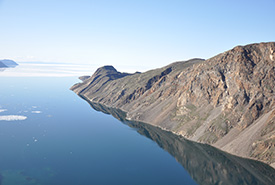10 good news nature conservation stories from 2017 that prove we have the solutions

Inlet around Lancaster Sound, NU © Parks Canada/Diane Blanchard
Nature conservation can seem a long and arduous journey. Current issues, from climate change to protecting north Atlantic right whales to micro-plastics in our oceans, can seem overwhelming. When viewed as a snapshot in time, these issues can even seem hopeless; too big, too complex and too political for resolution. But our history should give us hope. Many young people today are unaware about ozone depletion or pollution that once caused the egg shells of wild birds to thin and crack. These were once big, complex and political issues conservation issues, but thanks to past efforts, we have moved from problem to solution.
Effective conservation can only happen when we share the solutions, and not just the problems. Perhaps even more importantly, some of the underlying drivers of conservation are changing. There is broadening recognition that nature is critical for our economy and health, and new technologies are allowing everyone to participate in conservation. It’s clear that we need to roll up our sleeves and do more to protect species and habitats, and in the process we should be optimistic. We have many of the solutions — they just need to be applied at a scale that drives change.
Here are 10 stories of hope from 2017 from Canada and around the world that highlight our progress in protecting nature:
1. Protected areas continues to grow
Many countries are continuing to edge closer to international targets to protect 17 per cent of lands and inland waters by 2020. Globally, the amount of protected area has just reached 15 per cent, and the amount of protected area in Canada has grown by eight per cent in the last five years to 10.6 per cent. In 2017, the Natural Areas Conservation Program celebrated its 10-year anniversary. This program, supported by Environment and Climate Change Canada and administered by the Nature Conservancy of Canada (NCC), has protected over one million acres (404,600 hectares) across southern Canada, including some of Canada’s most threatened species and habitats. The number of protected areas in Canada will continue to grow as new federal and provincial parks are added, and as we better account for Indigenous and Community Conserved Areas and areas protected by land trusts.
2. Canada, and the world, is on track to meet commitments for marine protected areas
While Canada’s protection of marine and coastal areas had flatlined for many years, there has been a flurry of new protected areas, resulting in Canada achieving its interim goal of protecting five per cent of our oceans and coasts by 2017 (with a goal of 10 per cent by 2020). New marine protected areas include St. Ann Banks and Hecate Strait and Queen Charlotte Sound Glass Sponge Reefs. In addition, the government has delineated the final boundaries of the Tallurutiup Imanga/Lancaster Sound Marine Conservation Area.
In June, it was announced that the world is on track to meet the goal of protecting 10 per cent of marine areas and coasts. One of the most significant new announcements is that Mexico tripled the area of its marine protected areas to include 23 per cent of its national waters. This included the new Revillagigedo Marine Reserve, the largest marine protected area in North America.
3. More evidence that we can recover endangered wildlife in Canada
When I was growing up, the peregrine falcon was one of the poster species for Canada’s endangered species. Devastated by DDT, which caused egg shells to thin and crack, it was a species that seemed as exotic and elusive as tigers or elephants. Today, thanks to a phase-out of DDT and reintroduction programs (including in urban areas), I rarely go a few weeks without seeing a peregrine falcon.
In 2017, the peregrine falcon subspecies that lives throughout most of Canada was assessed as not at risk by the Committee on the Status of Endangered Wildlife in Canada, joining a growing list of recovered species. While we have a proven track record to recover many mammals and birds, and projects such as reintroducing plains bison in Banff National Park deservedly have a high profile, we need to do a better job of recovering other groups of species, such as plants and invertebrates, and protecting the habitats that support multiple at-risk species.
4. Overwhelming support for protected areas in Canada
Nature conservation ultimately fails if it’s not supported by people. Public support for creating nature reserves and conserving wildlife, and community support in and around protected areas, is critical. Canadians have a long history of parks, protected areas and wildlife conservation, so it’s no surprise (but very reassuring) that a poll in 2017 found that 89 per cent of Canadians support protected areas, and 79 per cent say they would support increased federal funding for the creation of new parks and protected areas.
5. More clinical evidence that nature is good for you
Anyone that spends time in nature knows the benefits of hiking, paddling or camping. Many cultural traditions also value time in nature, such as Shinrin-yoku (or forest bathing). Medical science is providing more evidence that people greatly benefit from spending time in nature, and this evidence is receiving increasing attention. The link between nature and health is not only being advanced by conservation organizations, including the International Union for Conservation of Nature’s #NatureForAll initiative, but also by groups such as the World Economic Forum.
Human health will be an important driver for conservation. The more recognition that nature conservation benefits everyone, the more support we’ll have for conservation.
6. International agreement to ban commercial fishing in the high Arctic
Climate change is altering the Arctic faster than any other place on Earth. The loss of sea ice will create huge areas of open water, making Arctic fishes, such as cod, susceptible to unsustainable commercial harvest. In 2017, nine countries — U.S., Canada, Russia, Norway, Greenland, China, Japan, Iceland, South Korea — and the European Union agreed to ban commercial fishing in three million square kilometres of offshore waters of the Arctic Ocean. The ban will last for at least 16 years while scientists study the potential impacts on the marine ecosystem. This ban is an outstanding example of protective, international conservation cooperation.
7. Sharing conservation information
Effective conservation needs good information. In 2017, iNaturalist, an app used to share information about species observations, surpassed five million observations. The app also introduced new image recognition software that suggests species identity, earning it a “letter of recommendation” from New York Times Magazine. Technology can certainly distract us from nature, but it can also be a catalyst for discovery and collaboration.
It’s never been easier to learn about species in your area, and through iNaturalist your observations can become part of our global record on biodiversity and help inform conservation decision-making. Many organizations are using iNaturalist for species inventories, including the bioblitz held in 2017 on NCC’s Big Trout Bay property, which catalogued over 850 species.
8. Mainstreaming conservation — business leaders and biodiversity
There was a time not so long ago when it seemed like the environment and economy were pitted against each other in mortal combat. The either/or politics of division is certainly still with us, but there is increasing recognition of the benefits when economy and ecology are integrated. Today, I’m hearing words from the mouths of CEOs and business leaders that make them sound a lot like well-informed conservation scientists.
In 2017, TD Bank and NCC released a report on the natural capital values of conserved forests that assigns a value to ecosystem services that forests provide to Canadians. Later in the year, CEOs and leaders from the Smart Prosperity Institute released a call to stand up for nature and increase our investment in conservation.
9. Thirty years after the Montreal Protocol, the ozone hole continues to shrink
There was a time when it seemed we were all destined to live on a dying planet that had lost its shield from UV solar radiation. In the early 1990s, Time Magazine featured the ozone hole on its cover and warned that “serious atmospheric ozone depletion has spread from the polar regions to temperate climes — and is worse than anyone thought.” We’re not in the clear yet, as new ozone-depleting chemicals are being discovered (such as dichloromethane), but we have made significant progress.
The Montreal Protocol on Substances that Deplete the Ozone Layer was signed 30 years ago in 1987. As a result, the hole in the ozone layer is shrinking and scientists expect the Antarctic ozone hole to recover back to 1980 levels by around 2070. These efforts to reduce CFCs should provide us with hope that there can be international cooperation on our collective efforts to reduce atmospheric pollution.
10. Climate and nature
There is continued (albeit slow) progress on climate change. China, the world’s largest carbon emitter, announced a new carbon market, and Canada’s pricing on carbon pollution is moving ahead. In addition to reducing emissions, there is increasing recognition that a carbon pollution solution also needs to include nature.
New research in 2017 highlighted the importance of natural climate change solutions, such as reforestation, and protecting wetlands, grasslands and forests. In addition to holding and storing carbon, there is increasing recognition that nature can help mitigate some of the impacts of climate change by providing services, such as holding flood waters and protecting coastal communities from storm surges.


